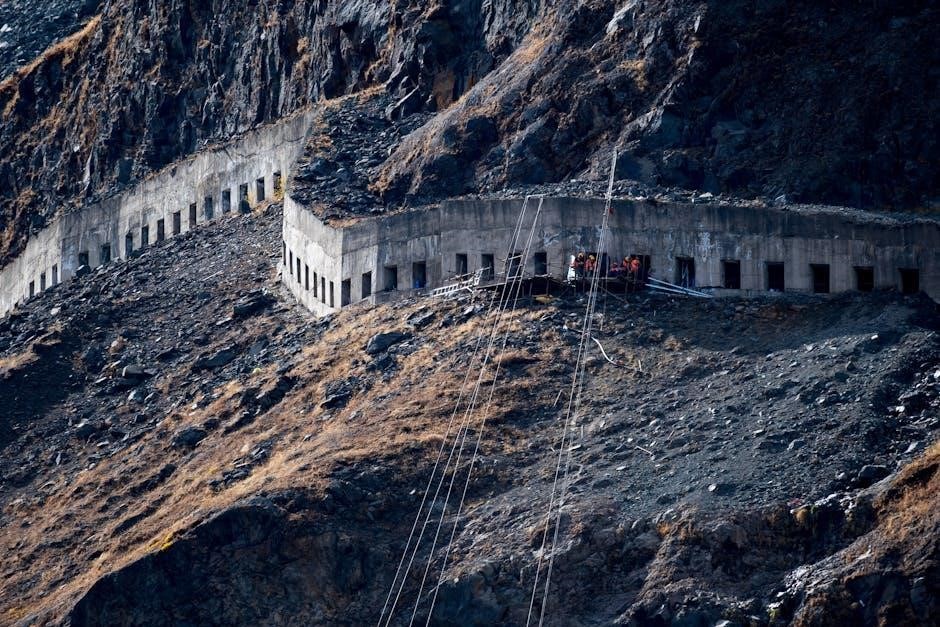A construction project schedule outlines the timeline, tasks, and milestones for building projects, ensuring organized planning and execution. It helps manage resources, dependencies, and progress tracking effectively.
1.1 Importance of Project Schedules in Construction
Project schedules are essential for ensuring timely completion, resource optimization, and effective risk management in construction. They provide a clear roadmap for tasks, milestones, and dependencies, enabling better organization and tracking of progress. By outlining timelines and deadlines, schedules help stakeholders understand expectations and allocate resources efficiently. They also facilitate early identification of potential delays or bottlenecks, allowing for proactive adjustments. Additionally, schedules improve communication among team members and stakeholders, ensuring alignment and reducing misunderstandings. Ultimately, a well-planned schedule is critical for delivering projects on time, within budget, and to the required quality standards, making it a cornerstone of successful construction management.
1.2 Overview of a Construction Project Schedule
A construction project schedule is a detailed plan outlining the sequence of tasks, timelines, and milestones for completing a project. It typically includes a list of activities, their start and end dates, and durations, ensuring a logical flow of work. The schedule also identifies dependencies between tasks and allocates resources effectively. For example, it may outline milestone events like foundation completion or roof installation. By providing a clear timeline, the schedule helps track progress, manage risks, and ensure adherence to deadlines. It serves as a roadmap for stakeholders, enabling efficient communication and coordination throughout the project lifecycle. A well-structured schedule is vital for achieving project goals successfully;

Key Components of a Construction Project Schedule
A construction project schedule includes tasks, timelines, resources, and dependencies, ensuring efficient project management and adherence to deadlines. It outlines the sequence of activities for successful completion.
2.1 Milestones in the Construction Project
Milestones are critical points marking the completion of significant phases in a construction project. They include events like foundation laying, structural completion, and final inspection. These milestones help track progress, ensuring the project stays on schedule. For example, completing the concrete floor slabs or installing the roof are key milestones. Each milestone represents a major achievement, allowing project managers to assess progress and make necessary adjustments. Regularly monitoring these points helps maintain project momentum and ensures timely delivery. Milestones also serve as reference points for stakeholders, providing clarity on the project’s status and remaining tasks.
2.2 Task Descriptions and Durations
Task descriptions outline specific activities within a construction project, while durations specify the time required to complete each task. For example, zoning approvals might take 30 days, while foundation work could require 60 days. These details ensure clarity and help track progress. Durations are estimated based on resource availability, weather, and dependencies. They are often displayed in Gantt charts or timelines, providing a visual overview of the project workflow. Accurate task descriptions and durations are essential for realistic scheduling, allowing teams to allocate resources effectively and manage timelines proactively. They also help identify potential bottlenecks early, ensuring the project remains on track.
2.3 Timelines and Dependencies
Timelines in a construction project schedule outline the start and finish dates for each task, ensuring activities are sequenced logically. Dependencies refer to the relationships between tasks, where one task cannot begin until another is completed. For example, installing electrical systems depends on walls being built. Understanding these dependencies is crucial for maintaining the project timeline and identifying potential delays. In a sample PDF, timelines are often visualized in Gantt charts, with arrows showing dependencies. This helps teams coordinate tasks effectively and allocate resources efficiently. Managing dependencies ensures that the project progresses smoothly, minimizing delays and ensuring all tasks align with the overall timeline.
2.4 Resource Allocation and Management
Resource allocation involves assigning the right materials, equipment, and labor to each task in the construction project schedule. Proper allocation ensures resources are used efficiently, avoiding over-allocation or shortages. In a sample PDF, this is often represented in resource tables or Gantt charts, showing which resources are assigned to each activity. Effective management requires regularly updating resource assignments and ensuring they align with task durations and dependencies. This helps prevent delays, cost overruns, and ensures smooth project execution. Tools like scheduling software can aid in visualizing and managing resources, making it easier to identify and resolve conflicts or over-commitments.
2.5 Monitoring and Controlling the Schedule
Monitoring and controlling the schedule ensures the construction project stays on track by regularly tracking progress and identifying potential delays. This involves comparing actual task completion dates with the planned schedule and addressing deviations promptly. In a sample PDF, this might include progress reports, updated Gantt charts, or dashboards highlighting schedule performance metrics. Effective monitoring requires using scheduling software or tools to track task statuses, dependencies, and resource utilization. Regular updates allow project managers to take corrective actions, such as reallocating resources or adjusting timelines, to keep the project aligned with its objectives. This process ensures transparency and accountability, maintaining stakeholder confidence in the project’s success.

Example Construction Project Schedule PDF
An example PDF provides a detailed timeline, task sequences, and milestones, serving as a visual guide for project planning and execution, adaptable to various projects.
3.1 What to Look for in a Sample PDF
When reviewing a sample construction project schedule PDF, look for a clear timeline, detailed task sequences, and key milestones. Ensure it includes dependencies between tasks, resource allocation plans, and progress tracking mechanisms. The document should outline start and end dates, critical paths, and potential bottlenecks. Check for clear labels, color-coded elements, and annotations that explain complex sections. Verify that the schedule is adaptable to different project sizes and types, offering a flexible framework for customization. A well-structured sample PDF should provide a comprehensive yet easy-to-understand overview of the project’s timeline and execution strategy.
3.2 How to Adapt the Example for Your Project
To adapt a sample construction project schedule PDF to your needs, start by understanding the structure and content of the example. Identify the key sections that apply to your project, such as timelines, task sequences, and resource allocation. Tailor the template by inputting your project-specific data, including start and end dates, milestones, and dependencies. Use project management software to edit and customize the document further. Collaborate with stakeholders to ensure alignment with project goals. Regularly review and update the schedule to reflect changes or progress. Finally, ensure the adapted schedule is clear, detailed, and accessible to all team members for effective execution.

Step-by-Step Guide to Creating a Construction Schedule
Define project scope, estimate task durations, sequence activities, identify dependencies, allocate resources, and develop a detailed timeline to ensure a structured and manageable construction plan.

4.1 Defining the Project Scope and Objectives
Defining the project scope and objectives is crucial for establishing a clear roadmap. Begin by outlining deliverables, such as the completed structure, permits, and inspections. Set SMART goals: specific, measurable, achievable, relevant, and time-bound. For example, aim to complete the project in 12 months, ensuring it’s realistic by considering factors like weather and material availability. Involve stakeholders to align priorities and communicate effectively through documentation and meetings. Establish a change management plan to handle scope creep. Balance scope with resources to avoid overambition. Document deliverables and quality standards, keeping the scope statement detailed yet flexible. This foundational step ensures everyone is aligned, preventing future conflicts and guiding decisions throughout the project.
4.2 Estimating Task Durations and Sequencing
Estimating task durations and sequencing is critical for creating a realistic construction project schedule. Start by breaking the project into smaller tasks, such as site preparation, foundation work, and framing. Use historical data or expert judgment to estimate durations. Consider potential delays like weather or material delivery times. Sequence tasks logically, ensuring predecessor tasks are completed before starting successors. Use tools like Gantt charts or the Critical Path Method to visualize dependencies. Assign durations to each task and identify bottlenecks. Regularly review and adjust estimates to maintain accuracy. Proper sequencing ensures a smooth workflow, while accurate durations keep the project on track and stakeholders informed.
4.3 Identifying Critical Path and Dependencies
Identifying the critical path and dependencies is essential for maintaining project momentum. The critical path determines the minimum project duration, as delays here directly affect the completion date. Start by mapping task relationships and identifying which activities cannot start until others are finished. Use techniques like the Critical Path Method (CPM) to calculate task sequences and durations. Dependencies include mandatory (hard logic) and discretionary (soft logic) links. Highlight tasks with zero float, as they are most sensitive to delays. Regularly review and update the critical path to adapt to changes. This ensures efficient use of resources and minimizes project extensions. Effective dependency management keeps the schedule aligned with project goals.
4.4 Assigning Resources and Roles
Assigning resources and roles is critical for ensuring tasks are completed efficiently. Begin by allocating labor, materials, and equipment to each task based on availability and expertise. Clearly define roles such as project manager, contractors, and subcontractors to avoid confusion. Use scheduling software to track resource utilization and prevent overallocation. Regularly review and adjust assignments to address shortages or conflicts. Effective resource management ensures tasks are completed on time and within budget. Communicate roles and responsibilities to all stakeholders to maintain accountability and coordination. This step is vital for turning the schedule into actionable plans that align with project goals and timelines.
4.5 Reviewing and Finalizing the Schedule
Reviewing and finalizing the schedule ensures accuracy and feasibility before implementation. Begin by verifying task durations, dependencies, and resource allocations for consistency. Check for any logical errors or overlaps that could delay progress. Seek feedback from stakeholders and team members to ensure the schedule aligns with project goals. Once approved, finalize the document and share it with all parties involved. Regularly update the schedule as changes occur to maintain its relevance. A well-reviewed and finalized schedule serves as a clear roadmap, ensuring everyone understands their responsibilities and timelines. This step is essential for achieving project success and meeting stakeholder expectations effectively.

Tools and Software for Construction Scheduling

Construction scheduling requires efficient tools to manage timelines and resources. Popular software includes Microsoft Project, Primavera P6, and Asana, offering Gantt charts, task tracking, and team collaboration. These tools help create detailed schedules, allocate resources effectively, and monitor progress in real-time, ensuring projects stay on track and within budget. Additionally, cloud-based platforms like Procore and PlanGrid provide accessibility and integration with other construction management solutions. Utilizing these tools enhances productivity and communication, making it easier to adapt to changes and maintain project efficiency.
5.1 Overview of Popular Scheduling Tools
Popular construction scheduling tools include Microsoft Project, Primavera P6, Asana, Smartsheet, and Procore. These tools offer features like Gantt charts, task dependencies, and resource allocation. Primavera P6 is ideal for large projects, while Asana and Smartsheet are user-friendly for smaller teams. Procore integrates scheduling with other construction management tasks, enhancing collaboration. PlanGrid focuses on real-time collaboration and document control. These tools help create and manage construction project schedules efficiently, ensuring timelines are met and resources are optimized. By leveraging these platforms, teams can streamline communication and adapt to project changes seamlessly.
5.2 How to Use Software for Effective Scheduling
To use software for effective scheduling, start by defining the project scope and objectives. Input tasks, durations, and dependencies into the tool, ensuring a clear sequence of activities. Assign resources to each task, balancing workload and availability. Use Gantt charts or timelines to visualize the schedule and identify the critical path. Regularly monitor progress, updating task statuses and adjusting timelines as needed. Utilize reporting features to share updates with stakeholders. Leverage collaboration tools to communicate changes and ensure alignment. Finally, train your team to use the software effectively, fostering a culture of transparency and accountability. This approach ensures efficient project management and timely delivery.

Common Challenges in Construction Scheduling
Construction scheduling often faces delays, scope changes, and resource shortages, impacting timelines and budgets. Coordination between teams and managing uncertainties further complicate the process.
6.1 Addressing Delays and Scope Changes
Delays and scope changes are common challenges in construction scheduling. Factors like weather, material shortages, or design modifications can disrupt timelines. To address delays, project managers should identify the root cause and adjust the schedule accordingly. Scope changes require careful evaluation to assess their impact on the timeline and budget. Using project management software, such as those discussed in Section 5, can help track changes and communicate updates to stakeholders. Regular progress meetings and contingency planning are essential to mitigate delays and ensure the project remains on track. Effective communication and adaptability are key to managing these challenges successfully.
6.2 Managing Risks and Uncertainties
Managing risks and uncertainties is critical to maintaining a construction project schedule. Potential risks include unforeseen site conditions, labor shortages, or material price fluctuations. To mitigate these, conduct regular risk assessments and develop contingency plans. Identify critical tasks that could impact the timeline and allocate buffers where necessary. Use project management tools to monitor risks and adjust schedules proactively. Communicating risks to stakeholders early ensures alignment and reduces delays. Regular reviews and updates to the project schedule help manage uncertainties effectively, keeping the project on track despite unexpected challenges.

Best Practices for Maintaining a Construction Schedule
Regularly update schedules, communicate changes clearly, and remain flexible to adapt to unforeseen issues. Use project management tools to track progress and involve the team in planning.
7.1 Regular Updates and Progress Tracking
Consistently updating the construction schedule and monitoring progress are crucial for maintaining project momentum. Regular updates ensure that all stakeholders are informed about the current status, helping to identify potential delays early. Use tools like Gantt charts or project management software to track progress visually. Compare actual progress with the baseline schedule to assess deviations. Conduct weekly or bi-weekly meetings to discuss updates and address issues promptly. This practice fosters collaboration, accountability, and transparency among team members; By integrating real-time data, you can make informed decisions and keep the project aligned with its objectives and timelines.
7.2 Communicating Schedule Changes to Stakeholders
Effectively communicating schedule changes to stakeholders is essential for maintaining trust and alignment. Use clear and concise language to explain the reasons for changes and their impact on the project. Provide updated timelines and highlight key adjustments in the construction project schedule example PDF. Ensure that all stakeholders, including contractors, clients, and team members, are informed promptly. Utilize email, project management software, or meetings to share updates. Be transparent about potential delays or resource reallocations. Offer a summary of the changes and their implications to avoid confusion. Consistent communication helps maintain credibility and ensures everyone is working toward the same goals. Regular updates foster collaboration and adaptability.
A well-planned construction project schedule ensures efficiency, timely completion, and stakeholder satisfaction. Utilizing tools and best practices maximizes success and minimizes delays.
8.1 Summary of Key Takeaways
A construction project schedule is essential for organizing timelines, dependencies, and resource allocation; It ensures clarity and accountability, helping teams meet deadlines and manage risks. The example PDF highlights key components like milestones, task durations, and critical paths, providing a visual and structured overview. Regular updates and stakeholder communication are crucial for maintaining accuracy. Utilizing tools like Primavera or MS Project can enhance scheduling efficiency. By following best practices and adapting templates, project managers can optimize workflows and deliver successful outcomes. A well-managed schedule is vital for achieving project goals and ensuring stakeholder satisfaction.

Additional Resources
Explore construction project schedule templates and guides for detailed planning. Check out recommended books on project management and online courses for advanced scheduling techniques.
9.1 Recommended Reading and Templates
Enhance your construction scheduling skills with essential resources. Download construction project schedule templates from reputable platforms like Smartsheet or Microsoft Project. Explore books such as “A Guide to the Project Management Body of Knowledge (PMBOK® Guide)” for foundational knowledge. Websites like Construction Business Owner and PlanGrid offer free construction scheduling templates and case studies. Additionally, consider enrolling in online courses on platforms like Coursera or LinkedIn Learning for in-depth training. These resources provide practical tools and insights to create and manage effective construction project schedules, ensuring your projects stay on track and within budget.